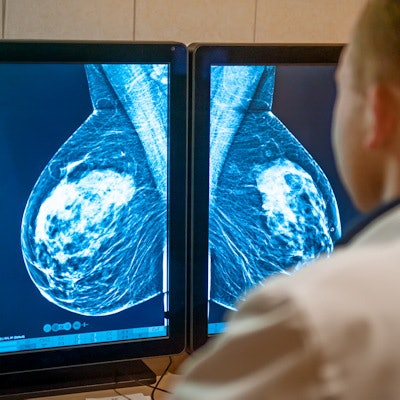
A mobile mammography program in Houston led to early breast cancer detection for women at risk of forgoing regular breast screening, according to the findings of a retrospective study published on August 4 in Academic Radiology.
The participants received mammography education and screening through the University of Texas MD Anderson Cancer Center's Project Valuable Area Life-Saving Exams in Town (VALET) program. Over the course of five years, the program helped to identify more than a dozen cancer cases, most of which were early stage.
"The program detected many cancers in an asymptomatic population facing barriers to breast cancer screening," wrote the authors, led by Dr. David Spak, an assistant professor at the breast imaging section of MD Anderson. "These findings are underscored by the cancers detected at an early stage with a favorable prognosis and support the need for development of similar programs."
Project VALET connects clinicians at MD Anderson with patients at local clinics in underserved communities. The goal is to provide mammography services to asymptomatic women without insurance or county assistance -- the types of women who are more likely to face cost and transportation barriers for traditional screening programs.
Through the program, a mobile mammography van rolls up to a local partnering clinic on the day of mammogram services. The van is staffed by a mammography technologist and project service coordinator, both of whom often speak multiple languages.
The coordinator first meets with patients inside the local clinic to gather patient history, get consent, and have them sign release forms. The patient then boards the van and undergoes mammography, which was performed using full-field digital mammography during the years of the study.
Offsite radiologists read the mammograms and provide results to referring clinicians and patients within two to 14 days. Patients referred for additional screening are directed to one of four facilities based on location and funding.
During the study years of 2012 to 2017, Project VALET screened 9,327 women. For the vast majority of patients (79%), it was the only screening they received in that timeframe.
Many patients were younger, and 60% were between the ages of 40 and 49. The majority identified as Hispanic (76%), followed by Black (10%) and Asian (8%).
The program identified cancers in 14 women, including 11 invasive cancers, for a cancer detection rate of 1.5 per 1,000 screening mammograms. Of the cancers with known staging status, the majority were stage I.
While the program helped to identify early-stage cancers in asymptomatic women, it also had a very high recall rate. During the five study years, 1,686 women were recalled for further screening, a rate of 17.8%. A further 101 were recommended for biopsy.
"These cases of invasive disease highlight the importance of mammographic screening for a patient population that may not have access to screening," the authors wrote. "The cancer detected may have progressed to a later stage with worse outcomes and these results support continued mammographic screening for breast cancer in women aged 40-49 years old."
The authors noted that other studies on mobile mammography programs have found similarly high recall rates and low cancer detection rates. Interestingly, at their own facility, the reading radiologists had a cancer detection rate of 5.8 and a recall rate of 9.8% -- suggesting something may have been unique about the population presenting for mammography at a mobile unit.
The authors thought the difference in performance could be due to the study's relatively young and largely Hispanic patient population, two groups of patients with lower cancer incidence rates. Similarly, the recall rate could have been high because the radiology team was often unable to get comparison slides for suspicious findings.
Since the study years, Project VALET has added digital breast tomosynthesis to its vans, which likely has improved cancer detection rates and recall rates. However, even with less-than-optimal rates, the authors believed the program is important for preventing late-stage cancer diagnoses in an at-risk population.
"The years of life potentially saved are underscored by the number of breast cancers detected at a low stage, without nodal involvement or distant metastasis," they concluded. "These findings support the need for the development of similar programs in other areas in the United States with a mission to care for the underserved community."



















